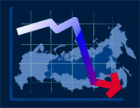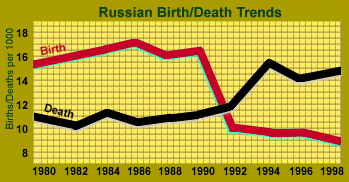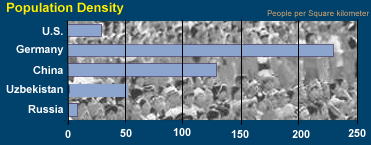Russia’s
Dwindling Population Ensures Rigid Foreign Policy
0155 GMT, 000413 The
Russian State Statistics Committee’s monthly report on Russia’s
socioeconomic situation recently stated that Russia’s death rate is
almost twice as high as its birth rate. At the current rate of decline,
Russia’s population shrinks by about 2,500 every day. Over time, this
decline will make difficult the mere survivability of the Russian state.
Russia will move to reassert control over much of its former empire in an
attempt to increase the population under Moscow’s control. To successfully counter greater threats with fewer people, Russian
foreign policy must become even more unyielding. The
Russian State Statistics Committee’s monthly report on Russia’s
socioeconomic situation recently stated that Russia’s death rate is
almost twice as high as its birth rate. At the current rate of decline,
Russia’s population shrinks by about 2,500 every day. Over time, this
decline will make difficult the mere survivability of the Russian state.
Russia will move to reassert control over much of its former empire in an
attempt to increase the population under Moscow’s control. To successfully counter greater threats with fewer people, Russian
foreign policy must become even more unyielding.

If Russia’s birth and
death rates stabilize at current levels, Russia’s population in 2050
will be a mere 116 million. However, there are few signs that birth rates
will rise or that death rates will stabilize. Russia health expert Dr.
Murray Feshback of Georgetown University, co-author of the Environmental
and Health Atlas of Russia, believes
that Russia’s population will likely drop to between 80 and 100 million
by 2050. Such a population crash would require an annual population growth
of -0.9 percent, the current rate is already -0.54 percent. New factors
that exacerbate current trends certainly support Feshback’s predictions.
An Accelerating Decline: Russia Faces New
Demographic Hurdles
One factor that
stabilized Russia’s population to date, immigration, has slackened. Only
379,700 people moved to Russia in 1999, mostly from other former Soviet
states, a 27 percent decrease from a year earlier. Meanwhile, emigration
from Russia – at about 214,000 – remains steady. All this adds up to a
net loss of 784,500 people in 1999 alone, according to the Russian State
Statistics Committee.
Diseases are also hitting
harder. There were 123,403 new cases of tuberculosis in Russia in 1999,
bringing Russia’s overall infection rate to 76 tubercular patients per
100,000 people, according to the Russian Health Ministry. (Forty per
100,000 constitutes an epidemic.) Complicating the problem, under an
upcoming amnesty program Russia will release 4,000 tubercular people this
year from its TB-rife prison system, half of whom carry drug resistant
strains of TB. The death rate from TB is higher than that of any other
major disease.
The death rate from
syphilis has increased 44-fold since the Soviet collapse. The infection
rate is now a disturbing 234 per 100,000 people. HIV infections
skyrocketed 250 percent to 31,000 in just the last year. These diseases
and others are crushing what is left of Russia’s health care system,
which in turn accelerates the demographic decline. The mortality rate of
Russian women who die in childbirth has increased to 44 per 100,000
people, 2.5 times the European average.
Other factors are only
now beginning to impact Russia’s demographic crisis. Russia’s suicide
rate is now 40 per 100,000, one of the highest in the world. The number of
registered alcoholics in Russia has doubled since 1992 to reach 2.2
million. More than 110,000 of these alcoholics are aged 12-16, according
to Deputy Health Minister Olga Sharapova.
Russia simply lacks the
basic health infrastructure to maintain its population. Roughly 50 percent
of Moscow’s residents live below the poverty line,
with an average monthly salary of $280 – 4.2 times the average
Russian income. Yet even in Russia’s wealthiest city, almost one-third
of Muscovites of draft age – the healthiest portion of the population
– have been deemed ineligible for the draft for health reasons,
according to Moscow’s military commissar Lt. Gen. Mikhail Sorokin.
Even the basic
necessities of population growth – families – are in decline. From
January 1999 to January 2000 the number of marriages decreased by 5
percent and the number of divorces increased by 23 percent. About 70
percent of all pregnancies since 1994 ended in abortions. Partly because
of this high abortion rate, one in five Russian couples are now infertile.
Russia
in the 21st Century: Working with Less, Looking for More
There is little evidence
that the Russian government is taking this internal threat seriously.
Kremlin demographics advisor Vladimir Mukomel asserts that “no expert
worth his salt could advance such predictions.” President-elect Vladimir
Putin has made few statements on public health issues, only making vague
statements about switching health authorities funded from local budgets to
the federal budget – a" TARGET="_new">http://www.stratfor.com/CIS/commentary/0003070012.htm">a
budget that has no money to spare. Reversing the trend will require a
massive relocation of resources and, above all, an increase in the birth
rate. But according to ITAR-Tass, Russia’s birth rate has been declining
throughout this century. Russia’s best-case scenario lies far below
zero-population growth. The country must adapt to having fewer people.
Unable
to avert its own impending demographic decline, Russia can extend its
political and economic reach over areas of the former Soviet daunting task. Its army is a mere
shadow of what it was during the Soviet era, yet its borders are not
appreciably shorter. Furthermore, in order to protect itself from Afghan
spillover and Chechnya-style separatism, it remains militarily engaged in
much of Central Asia.
Lacking the manpower,
Russia could attempt to follow the U.S. example and make up for quantity
with quality. However, Russia lacks the money to fund the across-the-board
technology explosion that would be required to modernize the Russian
military. Also, cruise missiles and the like are useful in projecting
power, they are less useful in protecting vast tracts of land.
Russia
does not have the population density to defend itself against expanding
neighbors – or to continually thwart separatist regions – so Russia
must take proactive steps. It cannot give an inch in the face of those
seeking to pick away at the edges. Russia
fears an expanding NATO to the west, thus Russia’s belligerent
statements against the inclusion of the Baltics" TARGET="_new">http://www.stratfor.com/CIS/commentary/0003030232.htm">Baltics
in NATO. Russia faces growing Islamic radicalism to the south, thus
its desire to lash" TARGET="_new">http://www.stratfor.com/CIS/commentary/0002230045.htm">lash
the Central Asian states together in an anti-terrorist grouping. And
then there is populous China to Russia’s southeast. Russia’s desire
for a political alliance barely eclipses the security fears caused by
large numbers of Chinese migrants – accounting for more than 70 percent
of the population of some sections of the Russian Far East, according to
the Indian daily newspaper The Hindu.

| |
2000
Population |
1999-2000
Population Growth |
Change
on a Year Earlier |
| Russia |
145.5
million |
-0.54
Percent |
-784,500 |
| China |
1300
million |
Approx.
2 percent |
+25,000,000 |
This sense of besiegement
is keen: Forty-five percent of Russians cannot name a country they
consider friendly toward Russia, according to a poll taken by the Agency
for Regional Political Research. If Russia sits still and does nothing,
NATO will absorb Ukraine and the Baltics, China will populate its Far
East, and the Taliban-inspired chaos of Afghanistan will creep north. It
is no wonder that Russia is seeking to make an example of Chechnya. Future
internal threats will be dealt with as harshly. As to external threats,
there is a reason why Russia" TARGET="_new">http://www.stratfor.com/SERVICES/giu2000/011700.ASP">Russia
revised its nuclear doctrine: to make it easier to use nuclear
weapons, the ultimate guarantors of territorial integrity.
Putin
is taking steps in this direction. In Russia’s" TARGET="_new">http://www.stratfor.com/CIS/commentary/0003070012.htm">Russia’s
most recent budget, Putin granted the Russian Defense Ministry a 50
percent increase in funding, a large portion of which is earmarked for
maintaining the reliability of the Russian nuclear arsenal. This
dependence will be viewed by all of Russia’s neighbors as an aggressive,
expansionist action. In reality, it is merely an act of self-defense by a
country that is dwindling away. copyright stratfor.com" TARGET="_new">http://www.stratfor.com">stratfor.com
|

